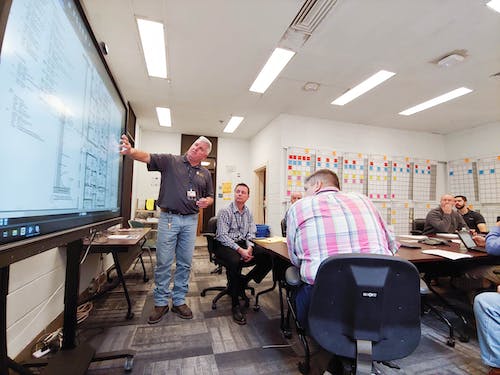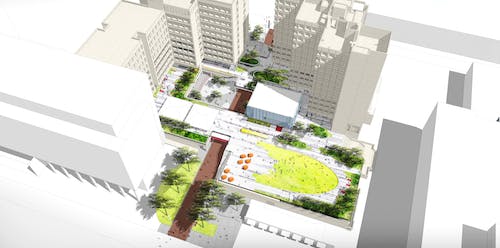How Construction Firm P. Agnes is Pushing the Boundaries of Site Documentation

Quick Summary
P. Agnes, a longstanding Philadelphia builder, adopted DroneDeploy in 2016 to streamline site documentation, progress tracking, and stakeholder communication. Their daily drone use during Temple University’s Anderson Hall renovation proved invaluable during COVID-19 shutdowns, enabling remote updates and reducing project delays. Key wins included risk management, site verification, and cost savings—like avoiding drain-related rework. Integration with Procore enhanced field-to-office coordination. With drone use now central to operations, P. Agnes plans to expand its program by scaling certified pilots and exploring 3D scanning to further improve safety and efficiency.
As one of the longest-standing construction companies in Philadelphia, P. Agnes is known for their construction management expertise, forward-thinking ideas, and innovative employees - while maintaining a lean approach. This inventive spirit is what first brought drone technology to their organization in 2016. “We saw the writing on the wall that drones would change this industry,” shared Ian Larson, Project Manager at P. Agnes. After integrating the software and gradually implementing its capabilities, the company now uses DroneDeploy to verify work, map existing conditions, and communicate progress to teams on and off-site for a variety of projects.
In late 2019, we interviewed project managers at P. Agnes shortly after they had been awarded Temple University’s Anderson Hall renovation project. In an exciting new move for the organization, this would be the first project using drone technology on a near-daily basis throughout the entirety of their building process. Now in 2021, P. Agnes has finished wrapping up construction, and handed over the renovated building to Temple University. We had the opportunity to catch up with Ian Larson, Matt DeBasio, and Anthony Williams to see how drone data aided their operations, both in reducing time and cost.

Photo Credit: P. Agnes
Adapting Construction to a Socially-Distanced World
Shortly after the onset of the COVID-19 pandemic, construction shut down throughout Pennsylvania, leaving project managers working on the backend while many subcontractors were unable to work due to site restrictions. These shutdowns impacted construction for the Anderson Hall renovation project, and P. Agnes needed to find a way to stay on track. In a time when on-site personnel were restricted, drone technology served as a safe “eye in the sky” for stakeholders from P. Agnes and Temple University. Tracking progress safely through repeated drone flights proved to be a successful communication solution in a socially distanced era – so much so that P. Agnes expects to continue this process post-pandemic.

Photo Credit: P. Agnes
Use Cases for Drones in Construction
DroneDeploy’s utilization for site documentation and progress tracking found a host of use cases for P. Agnes’ project at Temple University. Recording when work was completed, discovering site issues, and overlaying markup plans all found their applications here. In one instance, workers feared that two drains were covered by planting beds without their caps on. As a green roof, this would’ve clogged the drainage system entirely with soil, leading to significant leaking above the lecture halls. Workers could identify these drains on their drawings, but not in the field – which is where DroneDeploy came in handy.
Using a DroneDeploy map, workers quickly found where the drains were located before laying soil. They even measured the exact spot in which to dig. Within minutes, they found the drain and added the cap, saving a few thousand dollars and multiple days in the process. Without DroneDeploy, they would have had to dig up the entire bed.
Manual surveying costs 3-4x more to check invert or grading. DroneDeploy is much quicker and safer - and just as accurate.

Ian Larson, Project Manager, P. Agnes

Photo Credit: P. Agnes
DroneDeploy’s integration with Procore was a pivotal deciding factor for bringing drone technology to widespread use within P. Agnes. Combining DroneDeploy’s inspection workflow with Procore’s map overlays gives managers the full size and scope of a project. “Before using this integration, we would manually walk the site to take pictures,” said Matt DeBasio, Project Estimator, “DroneDeploy takes this process to the next level.”
Drone Data as a Risk Management Tool
Themes of accountability and risk management were paramount in our discussion with P. Agnes, as they explained how situations like these exemplified the power of drone insights. “This is an accountability tool for subcontractors, project managers, and stakeholders, and it communicates transparency to the client,” Matt stated. "If you can document exactly what you’re doing on a regular basis, and have clear, objective, visual proof of what’s exactly going on – it’s like an insurance policy. It’s a tool to manage risk.” Anthony Williams, Assistant Project Manager, added, “It just keeps people honest.”
By having this accountability tool in their arsenal, P. Agnes has been able to enhance safety on their construction sites. For every project, they assign a safety manager and have a set of safety protocols, however, drone data enables them to have visual proof of what goes on. Drone capabilities also allow their team to plan ahead with regard to safety. For a precast façade installation for one of their healthcare projects, they plan to use the vertical flight tool to inspect the panels after they have been installed. This would prevent the need for someone to go up to inspect the panels via a high reach or with another piece of equipment. “Any time we can use the drone to do these types of things it will be much safer and lessen the risk exposure of having an individual put themselves in a potentially hazardous situation,” explained Anthony.
Forging Ahead with Drone Technology
As a company, we’ve seen how P. Agnes has rapidly innovated their drone program and capabilities in the past two years, leaving them with a defined set of use cases to validate this technology on upcoming job sites. Currently, P. Agnes has 3 FAA-certified drone pilots and vehicles, each operating at their largest project sites. They plan to further scale their drone operations with applications in 3D laser scanning. In the future, P. Agnes also aims to have dedicated drone pilots on each project rather than using this as a sub-role for select field members. With the rising demand they’re seeing within the company, this goal is likely to come to fruition.
We’re looking forward to seeing how P. Agnes continues to push the boundaries of site documentation in the coming years. If you’re interested in bringing drone technology to your job sites, watch our webinar on what’s next for drones in construction, or talk to one of our representatives.
FAQ
Related articles
Ready to manage your data from the very start?
Book a quick call to see how DroneDeploy streamlines capture from construction through building ROI.
.svg)
.png)


